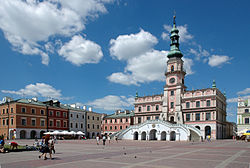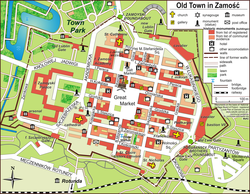Zamość
| Zamość | |||
|---|---|---|---|

Market Square
|
|||
|
|||
 |
|||
| Coordinates: 50°43′14″N 23°15′31″E / 50.72056°N 23.25861°E | |||
| Country |
|
||
| Voivodeship | Lublin | ||
| Powiat | City County | ||
| Gmina | Zamość | ||
| Established | 1580 | ||
| Town rights | 1580 | ||
| Government | |||
| • Mayor | Andrzej Wnuk | ||
| Area | |||
| • City | 30.48 km2 (11.77 sq mi) | ||
| Elevation | 212 m (696 ft) | ||
| Population (2014) | |||
| • City | 65,149 | ||
| • Density | 2,100/km2 (5,500/sq mi) | ||
| • Metro | 140 274 | ||
| Time zone | CET (UTC+1) | ||
| • Summer (DST) | CEST (UTC+2) | ||
| Postal code | 22–400 to 22–410 | ||
| Area code(s) | (+48) 084 | ||
| Car plates | LZ | ||
| Website | http://www.zamosc.pl | ||
| Old City of Zamość | |
|---|---|
| Name as inscribed on the World Heritage List | |
 |
|
| Location | Poland |
| Type | Cultural |
| Criteria | iv |
| Reference | 564 |
| UNESCO region | Europe and North America |
| Inscription history | |
| Inscription | 1992 (16th Session) |
Zamość pronounced [ˈzamɔɕt͡ɕ] (Yiddish: זאמאשטש Zamoshtsh) is a city in southeastern Poland, situated in the southern part of Lublin Voivodeship (since 1999), about 90 km (56 mi) from Lublin, 247 km (153 mi) from Warsaw and 60 km (37 mi) from the border with Ukraine. In 2014, the population was 65,149.
The historical centre of Zamość was added to the UNESCO World Heritage List in 1992, following a decision of the sixteenth ordinary session of the World Heritage Committee, held between 7 and 14 December 1992 in Santa Fe, New Mexico, United States. As described by UNESCO:
Zamość is a unique example of a Renaissance town in Central Europe, consistently designed and built in accordance with the Italian theories of the "ideal town," on the basis of a plan which was the result of perfect cooperation between the open-minded founder, Jan Zamoyski, and the outstanding architect, Bernardo Morando. Zamość is an outstanding example of an innovative approach to town planning, combining the functions of an urban ensemble, a residence, and a fortress in accordance with a consistently implemented Renaissance concept. The result of this is a stylistically homogeneous urban composition with a high level of architectural and landscape values. A real asset of this great construction was its creative enhancement with local artistic architectural achievements.
Zamość is about 20 kilometres (12 miles) from the .
Zamość was founded in 1580 by the Chancellor and Hetman (head of the army of the Polish-Lithuanian Commonwealth), Jan Zamoyski, on the trade route linking western and northern Europe with the Black Sea. Modelled on Italian trading cities, and built during the late-renaissance period by the Padovani architect Bernardo Morando, Zamość remains a perfect example of a Renaissance town of the late 16th century. It retains its original street layout, fortifications (Zamość Fortress) and a large number of original buildings blending Italian and central European architectural traditions.
...
Wikipedia



